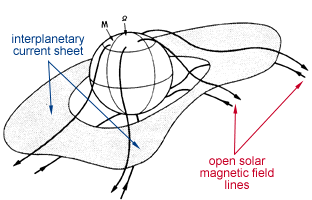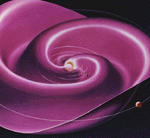The interplanetary magnetic field (IMF) is a part of the Sun's magnetic field that is carried into interplanetary space by the solar wind. The interplanetary magnetic field lines are said to be "frozen in" to the solar wind plasma. Because of the Sun's rotation, the IMF, like the solar wind, travels outward in a spiral pattern that is often compared to the pattern of water sprayed from a rotating lawn sprinkler. The IMF originates in regions on the Sun where the magnetic field is "open"--that is, where field lines emerging from one region do not return to a conjugate region but extend virtually indefinitely into space. The direction (polarity, sense) of the field in the Sun's northern hemisphere is opposite that of the field in the southern hemisphere. (The polarities reverse with each solar cycle.) The heliospheric current sheet
The heliospheric current sheet
 Along the plane of the Sun's magnetic equator, the oppositely directed open field lines run parallel to each other and are separated by a thin current sheet known as the "interplanetary current sheet" or "heliospheric current sheet" (see the figure above). The current sheet is tilted (because of an offset between the Sun's rotational and magnetic axes) and warped (because of a quadrupole moment in the solar magnetic field) and thus has a wavy, "ballerina skirt"-like structure as it extends into interplanetary space (see the figure on the left). Because the Earth is located sometimes above and sometimes below the rotating current sheet, it experiences regular, periodic changes in the polarity of the IMF. These periods of alternating positive (away from the Sun) and negative (toward the Sun) polarity are known as magnetic sectors.IMF Bz
Along the plane of the Sun's magnetic equator, the oppositely directed open field lines run parallel to each other and are separated by a thin current sheet known as the "interplanetary current sheet" or "heliospheric current sheet" (see the figure above). The current sheet is tilted (because of an offset between the Sun's rotational and magnetic axes) and warped (because of a quadrupole moment in the solar magnetic field) and thus has a wavy, "ballerina skirt"-like structure as it extends into interplanetary space (see the figure on the left). Because the Earth is located sometimes above and sometimes below the rotating current sheet, it experiences regular, periodic changes in the polarity of the IMF. These periods of alternating positive (away from the Sun) and negative (toward the Sun) polarity are known as magnetic sectors.IMF Bz
The IMF is a vector quantity with three directional components, two of which (Bx and By) are oriented parallel to the ecliptic. The third component--Bz--is perpendicular to the ecliptic and is created by waves and other disturbances in the solar wind. When the IMF and geomagnetic field lines are oriented opposite or "antiparallel" to each other, they can "merge" or "reconnect," resulting in the transfer of energy, mass, and momentum from the solar wind flow to magnetosphere The strongest coupling --with the most dramatic magnetospheric effects-- occurs when the Bz component is oriented southward.
The IMF is a weak field, varying in strength near the Earth from 1 to 37 nT, with an average value of ~6 nT.
--------------------------------------------------------------------------------
The cartoon showing the tilted current sheet and open solar magnetic field lines is adapted from Smith et al., Observations of the interplanetary sector structure up to heliographic latitudes of 16 degrees: Pioneer 11, J. Geophys. Res., 83, 717, 1978. The artist's conception of the heliospheric current sheet was obtained from J. Todd Hoeksema, Stanford University.
